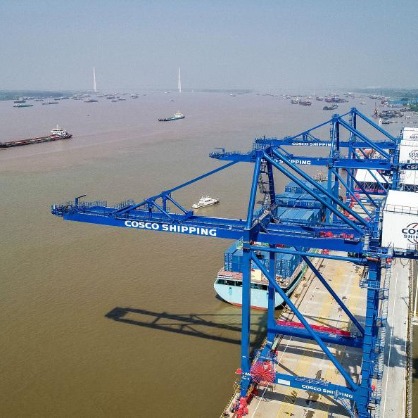Gu Qiangsheng can clearly recall the rainy day about 10 years ago when he walked along a container terminal in Wuhan with Xi Jinping, general secretary of the Communist Party of China (CPC) Central Committee.
It was on the morning of July 21, 2013, that Xi inspected the Yangluo container terminal in Wuhan, the first stop of his three-day trip to central China’s Hubei Province.
Xi first inspected the terminal’s central control room to hear a briefing on the construction of the port, and then went to the dock in spite of strong winds and heavy rain. With his trousers rolled up, Xi waded through the water holding an umbrella.
“It was raining heavily. Even though the general secretary saw I was wearing a raincoat, he kept leaning his umbrella toward me,” said Gu, who was at that time the general manager of Wuhan Port Group Co., Ltd. Gu, who is now in his 70s, said Xi’s kind gesture was heartwarming.
“What are the prospects of inland ports? How many containers are sent to the southeast coast?” asked the general secretary.
Sixty percent were foreign trade containers and 40 percent were domestic trade containers, Gu replied. “Inland ports have great potential.”
“How do you overcome the funding challenges?” An inquisitive Xi continued.
“The Wuhan Port Group is a joint venture of the state-owned assets supervision and administration commission of Wuhan, the Shanghai International Port (Group) Co., Ltd., and other investors. We run the port together,” Gu explained.
Stopping next to a crane, Xi asked whether the equipment was imported or made in China.
“All of the equipment is domestically produced and meets world-class quality standards,” Gu replied.
“The general secretary and I talked for about 10 minutes, like chatting about day-to-day lives,” Gu recalled. “He attached great importance to economic development. While taking a close look at the situation on the ground, he asked detailed questions, all of which were very much to the point.”
Ports are barometers of the national economy, and Wuhan, located in the geographical heart of China’s economy, is an important water, land and air transportation hub, as well as a shipping center in the middle reaches of the Yangtze River. In addition to feeling the powerful heartbeat of China’s economy, the visit was also meant to find empirical evidence in support of decision-making.
At a meeting attended by leading officials of five provinces, Shanghai Municipality and Wuhan City two days later, Xi listed major issues that required in-depth research and study from six aspects when trying to comprehensively deepen China’s reform. This provided a methodology to answer questions arising from the reform.
More than three months later, at the Great Hall of the People in Beijing, the third plenary session of the 18th CPC Central Committee adopted the “Decision of the Central Committee of the CPC on Some Major Issues Concerning Comprehensively Deepening the Reform.”
There is no doubt that in-depth and meticulous research had been conducted before formulating this epoch-making blueprint.
Xi views research and study as cherished Party traditions and essential skills needed to complete work well, and he always leads the way by conducting visits at the community level to see the real conditions in the country. Since the 18th CPC National Congress in 2012, Xi has left footprints across the country.
In order to identify and resolve major problems that could hamper China’s high-quality development and modernization drive, the CPC Central Committee made a decision last month to launch a Party-wide campaign of in-depth research and studies.















